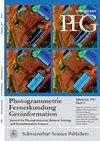GMES4Mining - Description of a flooding process in mining areas using spectral indices on multioral landsat imagery
Q Social Sciences
引用次数: 0
Abstract
The R&D project GMES4Mining aims to support particular tasks within the different phases of a mining life cycle. Within this project one task concentrates on vegetation monitoring in order to detect damages caused by mining. In Germany several mining districts have been exploited for a long time. Mining areas are associated with certain environmental hazards, such as surface subsidence and flooding. The change in substrate compaction due to mineral extraction provokes surface subsidence, down to the point that the surface can reach the groundwater level. This phenomenon provokes negative effects on vegetation, which can be observed using remote sensing. A temporal series of Landsat images from 1999 to 2012 has been used to detect temporal changes in vegetation by calculating 3 spectral indices. The spectral indices relate to vegetation greenness, leaf pigments and water content. The aim of this study is to detect early indications and to monitor the process of flooding in abandoned mining sites, to prevent environmental and civil hazards. Moreover, it is investigated whether these indices are appropriate to detect flooded areas and to describe the vegetation succession, once a flooded area is drained. It is expected that this methodology will be applicable to the future Sentinel-2 data, in order to monitor and prevent hazards in mining areas.GMES4Mining -利用多卫星图像上的光谱指数描述矿区的洪水过程
研发项目GMES4Mining旨在支持采矿生命周期不同阶段的特定任务。在这个项目中,一项任务集中于监测植被,以便发现采矿造成的损害。在德国,几个矿区已经开采了很长时间。矿区与某些环境危害有关,如地表沉陷和洪水。由于矿物开采而引起的基材压实的变化引起地表下沉,直到地表达到地下水位。这种现象对植被造成了负面影响,这可以通过遥感观察到。利用1999年至2012年的时间序列Landsat图像,通过计算3个光谱指数来检测植被的时间变化。光谱指标与植被绿度、叶片色素和含水量有关。这项研究的目的是发现早期迹象并监测废弃矿区的洪水过程,以防止环境和民事危害。此外,本文还探讨了这些指标是否适用于探测洪涝地区和描述洪涝地区的植被演替。预期这一方法将适用于未来的哨兵2号数据,以便监测和防止矿区的危险。
本文章由计算机程序翻译,如有差异,请以英文原文为准。
求助全文
约1分钟内获得全文
求助全文
来源期刊

Photogrammetrie Fernerkundung Geoinformation
REMOTE SENSING-IMAGING SCIENCE & PHOTOGRAPHIC TECHNOLOGY
CiteScore
1.36
自引率
0.00%
发文量
0
审稿时长
>12 weeks
 求助内容:
求助内容: 应助结果提醒方式:
应助结果提醒方式:


